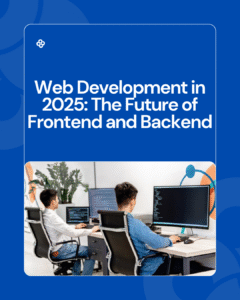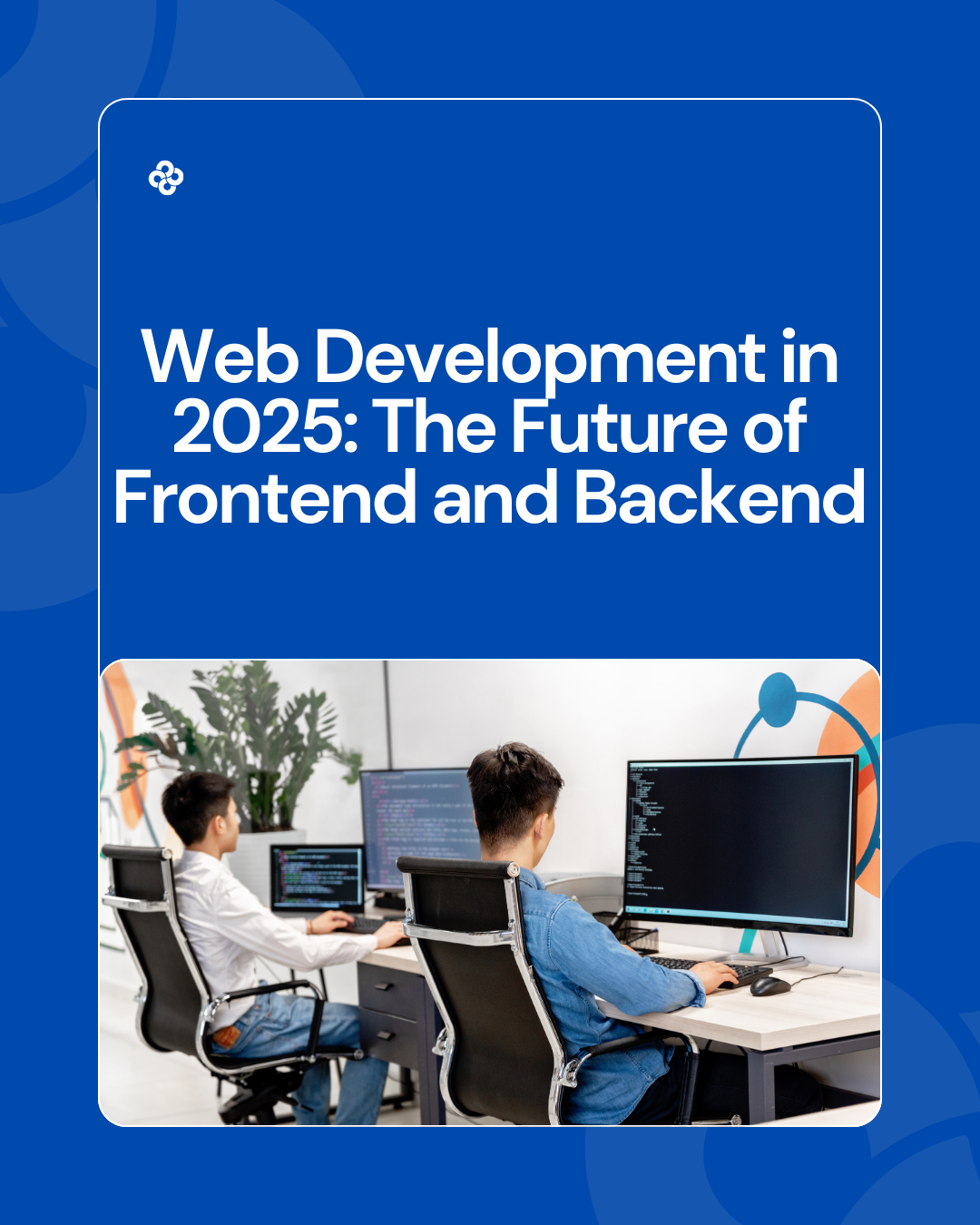Web Development in 2025: The Future of Frontend and Backend
Introduction
The landscape of web development in 2025 is starkly contrasted to what it was even just five years prior. The internet has transformed into the backbone of almost every sector, and websites are no longer simply “online brochures”—they are vibrant, dynamic systems that generate revenue, customer interaction, learning, healthcare, and entertainment. Whether it is an SaaS platform powered by AI, a 3D immersive eCommerce website, or a decentralized blockchain app, web development today has become much more than writing pages and databases.
At the core of this transformation are two fundamental pillars: frontend and backend development. Frontend manages what the end-user sees and touches, whereas the backend drives it all in the background—from data storage to authentication, scalability, and security. In 2025, both domains are changing at a faster pace than ever before, fueled by artificial intelligence, edge computing, microservices, Web3, immersive UI/UX design, and cloud-native infrastructures.
This article dives deep into the future of frontend and backend development in 2025, presenting the newest frameworks, tools, trends, challenges, and technologies required by developers to remain current.
The State of Web Development in 2025:
1. Explosive Market Growth
By 2025, the demand for websites and applications across the globe has never been higher. All businesses—whether a multinational, a freelancer, or a small shop—need a professional web presence. Industry reports indicate that the market for web development is in the hundreds of billions of dollars and continues to grow fast.
SaaS dominance: Subscription models are booming. From productivity software to industry-specific software, companies are opting for SaaS over old-fashioned products.
E-commerce boom: Online shopping is still on the rise, with eCommerce sites emphasizing speed, customization, and in-depth experiences.
Enterprise digitalization: Big enterprises mostly depend on tailor-made web applications for workflow automation, data analysis, and customer engagement.
2. AI and Automation:
- Artificial intelligence is the largest game-changer in 2025. GitHub Copilot, ChatGPT, and UI generators powered by AI are part of the developer’s daily arsenal.
- AI is now employed by developers to create boilerplate code, write tests, debug, and even optimize database queries.
- AI-driven design systems generate responsive layouts and color schemes based on accessibility and branding.
- Automation tools deploy, monitor, and scale—leaving developers to concentrate on creativity and problem-solving.
- Rather than displacing developers, AI has complemented them, making coding quicker, cleaner, and more efficient.
3. New Technologies Shaping the Industry:
Edge computing: Applications are executed nearer to the users, lowering latency and increasing performance.
WebAssembly (WASM): High-performance applications (e.g., video editing, games) are now executed natively in browsers.
Blockchain & Web3: dApps are opening up new avenues in finance, ownership, and data privacy.
AR/VR & 3D web: Sites are getting more immersive with 3D product views, VR tours, and AR interactions.
Sustainable development: Green coding practices, green hosting, and energy-efficient sites are high on the agenda.
Frontend Development in 2025
Frontend development has made a tremendous leap. What was once plain HTML, CSS, and JavaScript now consists of robust frameworks, AI tools, and immersive experiences.
1. Contemporary Frontend Frameworks:
Framework wars are in full swing in 2025, but some have taken the lead:
React & Next.js: Remain in ascendance, particularly for enterprise applications, with improved server-side rendering and static site generation.
Remix: Focused on performance and web standards, Remix gained popularity among developers who prefer lightweight and fast frameworks.
Svelte & Svelte Kit: Known for speed and simplicity, they have a strong developer community.
Solid.js: An emerging framework offering high performance and fine-grained reactivity.
These frameworks emphasize speed, accessibility, and developer experience, making frontend development smoother.
2. AI-Powered Design and Development:
AI has entered frontend in a big way:
- AI tools create responsive layouts, components, and animations from wireframes.
- Voice coding assistants assist developers in rapid construction of UIs.
- AI takes care of color contrast, typography, and accessibility by default.
3. UI/UX Trends
In 2025, user experience rules. Some trends are:
Minimalism 2.0: Simple, clutter-free interfaces.
Dark Mode Evolution: Intelligent adaptive dark/light themes depending on environment.
3D & Immersive Elements: AR product previews, VR tours, and animated 3D models.
Micro interactions: Tiny animations that make experiences feel natural.
Accessibility-First: Websites for all, no matter the disability.
4. Progressive Web Apps (PWAs)
PWAs keep on increasing in 2025 as companies favor fast, installable, offline-enabled apps over costly native apps. PWAs offer the reach of the web together with the native-like performance.
5. Performance Optimization
Performance matters:
- Edge computing and CDNs offer the lightening-fast websites.
- Lazy loading, code splitting, and WebAssembly make speed optimization.
- Mobile-first and low-bandwidth-friendly designs become the norm.
Backend Development in 2025
While frontend is visible, backend is where the power is real. Backend development in 2025 is all about scalability, security, and velocity.
1. New Backend Frameworks
Backend frameworks are changing fast:
Node.js, Demo & Bun: Universal usage makes JavaScript/TypeScript backends the norm.
Go & Rust: High-performance languages are becoming popular for scalable applications.
Python & Django/Fast API: Still popular for data-intensive applications.
2. Microservices & API-First Approach
Monolithic applications are being replaced by microservices that provide independent scaling and simpler deployment. APIs (REST, Graph QL, RPC) are the foundation of today’s apps.
3. Server-less Architectures
Server-less is hot. Developers do not care about servers—they simply deploy functions that automatically scale. This saves cost and complexity.

4. Databases of the Future
- Distributed Databases (Cockroach DB, Yuga-byte DB) provide global scalability.
- AI-Optimized Databases forecast queries and auto-optimize indexes.
- Hybrid SQL + NoSQL databases provide flexibility.
5. Security-First Backend
Cyberattacks are more advanced in 2025. Backend developers value:
- Zero-trust architectures.
- End-to-end encryption.
- AI-based anomaly detection.
6. Cloud-Native & Edge Deployments
Backend applications are cloud-first, deployed on AWS, Azure, GCP, and edge networks for worldwide reach and low latency.
The Convergence of Frontend & Backend:
The frontend-backend divide is fading:
- Full-Stack Frameworks (Next.js, NXT, Remix, Redwood JS) enable developers to do both.
- JAM stack & Headless CMS enable decoupled frontends with robust backends.
- AI Full-Stack Assistants are now able to develop end-to-end applications with developer support.
AI in Web Development:
AI is all around 2025:
Code generation: AI generates frontend and backend code.
Automated testing: AI executes tests and discovers vulnerabilities.
Deployment automation: AI regulates performance and scales applications.
Low-code/no-code platforms: Allow non-developers to develop applications.
The Future Developer Skillset:
Developers require the following to thrive in 2025:
Frontend Skills
- Expertise in frameworks (React, Next.js, Svelte).
- Excellent UI/UX design knowledge.
- Understanding of accessibility & performance optimization.
Backend Skills
- API-first development.
- Microservices, server-less, and cloud-native architectures.
- Database optimization and security skills.
Soft Skills
- Problem-solving, adaptability, and collaboration with AI tools.
- Challenges & Opportunities
Rapid Tech Changes: Developers need to learn continuously.
AI Dependency: Over-reliance on automation is a risk.
Security Threats: Hackers are also catching up.
Opportunities: Immersive web, AI-powered platforms, and sustainable tech.
Conclusion
Web development in 2025 is smarter, faster, and more connected than ever. Frontend development is building engaging, user-centered experiences fueled by AI and emerging frameworks. Backend development provides scalability, security, and performance with microservices, serverless, and cloud-native infrastructure.
For developers, tomorrow is brimming with possibility—if only they continue learning and evolving. The future web applications will be defined by individuals who know how to integrate imagination, technical skills, and AI-based tools to create the internet of the future.
